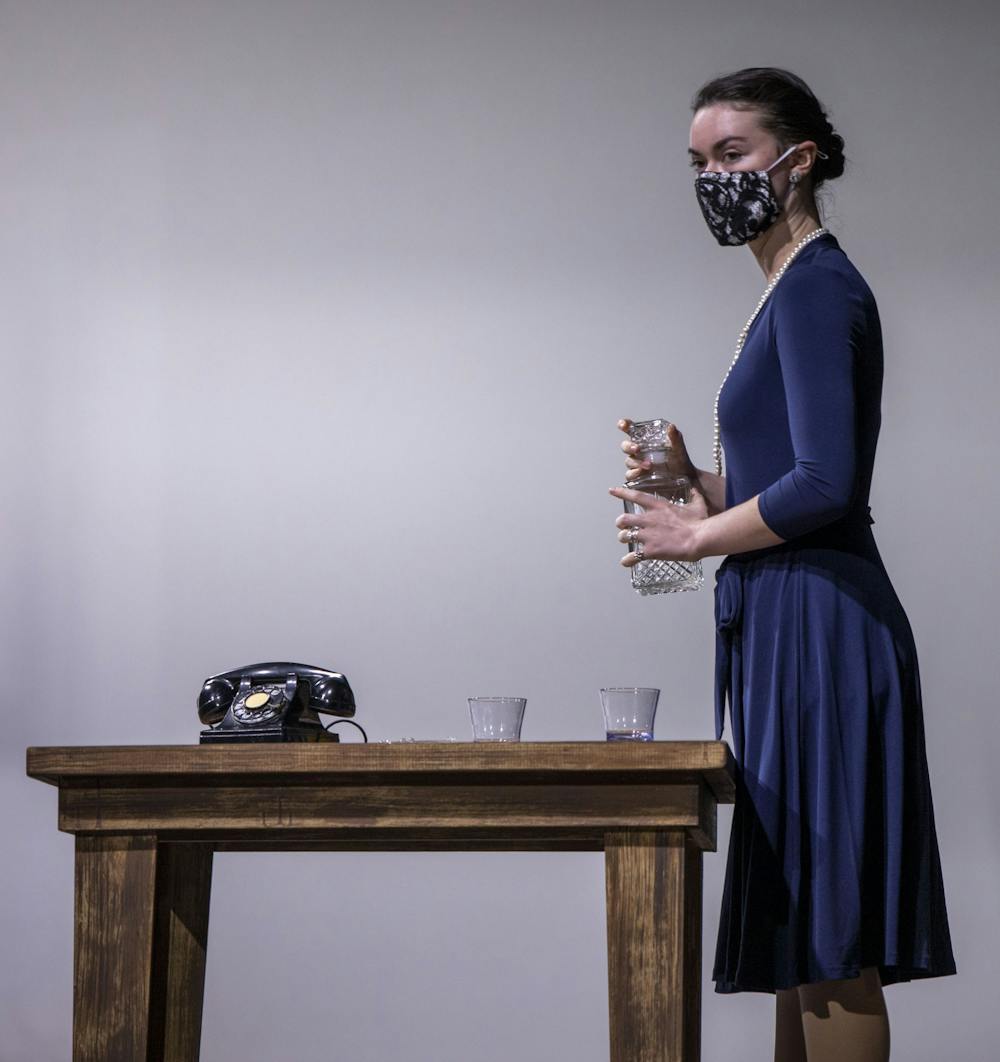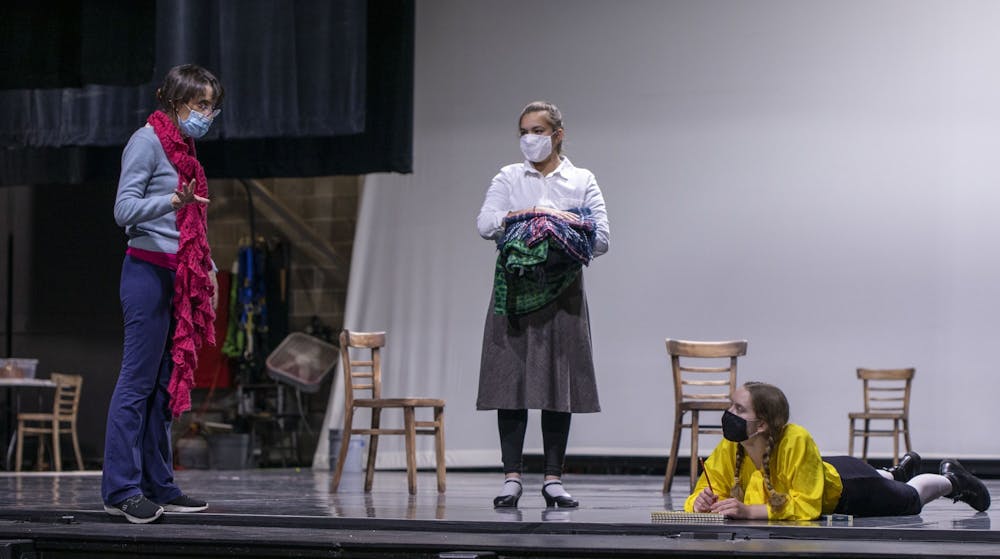Upcoming Department of Theatre and Dance shows
“Overpass” will be performed live virtually Oct. 8-9
“The Children’s Hour” will open in person in University Theatre Oct. 15
“A Modern Dance” will be performed in person in Korsgaard Dance Studio Oct. 22-24
“She Kills Monsters” will be performed live virtually Oct. 29-31, Nov. 1
“Babel” will be performed live virtually Nov. 10-13
“The Gift” will be performed in person on the Fine Arts Terrace Nov. 20-22
In March 2020, after over two months of rehearsals, the cast of “Intertextuality” learned it wouldn’t be able to perform its show on Ball State’s campus as planned due to in-person events being suspended.
“Of course, everyone was a little devastated, and we basically thought we would never get a chance to do the show,” said Raven Williams, junior dance and psychology double major.
“Intertextuality” was scheduled to debut in University Theatre April 23. Williams said choreographer Mya Ajanku emailed the cast in July to tell them they would be able to perform during the fall 2020 semester.
Williams said some of the choreography from the spring was changed to allow for social distancing and decrease contact with frequently-touched objects.
Additionally, all performers wore masks during rehearsals and performances. Sarah Jenkins, managing director for the Department of Theatre and Dance, said audience seating for in-person performances is socially distant, but people from the same household are allowed to sit next to each other. All audience members are asked to wear masks, and contact information is taken before the show begins in case contact tracing is necessary.
Jenkins said the seats in University Theatre are disinfected before and after each use, and the department is transitioning to paperless programs to minimize surface contact. She said it wasn’t until June 2020 that the Department of Theatre and Dance faculty chose what shows it would perform for the 2020-21 school year.

Signs and tape over seats in University Theatre indicate where audience members can sit. University Theatre has a nearly 450-seat capacity, but a maximum of 106 audience members can be accommodated with socially distanced seating. Jaden Whiteman, DN
Typically, Jenkins said, faculty in the department choose what shows they want to perform by October of the previous school year. Faculty and students within the department knew the planned shows for 2020-21, but some titles needed to be changed.
“We shifted around our production season, and this summer, decided to find other titles that would work better with COVID [and] physical distancing on campus,” Jenkins said.
“Intertextuality” finished its in-person performances Sept. 27. Director and choreographer Jenn Meckley said each performance had at least 60 audience members.
“I didn’t know what to expect,” Meckley said. “I felt like it could go both ways. People may have been hesitant to come to the performance because of the virus, or they were really itching and willing to go see this live performance because they were wanting that social interaction.”
Meckley said performers wore masks in their own squares that were marked by taping the floor of dance studios during rehearsals.
“As a choreographer, I tried to keep the camaraderie and the community aspect the same,” Meckley said. “I’m trying to still voice the importance of dancer interaction inside of the space. However, a lot of it felt very different.”
Williams said performing with a face mask required her to be more expressive with her eyes and body while performing.
“We still had our bodies, so we had to take that extra step to add that extra detail to our bodies while dancing,” Williams said. “I think that really helped get the message across, and it was received really well by the audience.”
Williams said she was afraid at first to perform wearing a mask to audience members wearing masks.
“One of the biggest things as a performer is you feed off of the audience’s energy,” she said. “The first couple of runs, it was a little awkward, but I think that barrier broke because the audience saw that we were having energy and having a good time.”

Sophomore acting major Bernadette Harding holds an empty whiskey decanter at “The Children’s Hour” rehearsal Oct. 6. Laura Pierson, stage manager for “The Children’s Hour,” said performers are not allowed to have liquids on stage as a COVID-19 precaution. Jaden Whiteman, DN
In addition to socially-distant in-person shows, Jenkins said the Department of Theatre and Dance will be presenting some shows live over Zoom.
“The challenge for us is to figure out how to differentiate ourselves with Zoom productions because so many theater and dance companies are in the same predicament,” Jenkins said. “We have to ask, ‘How can we creatively produce this performance so that people want to watch it and sit for an hour and watch a streamed version?’”
Maggie Perisho, junior directing major and director of “Overpass,” said the playwright gave her permission to perform the show virtually. “Overpass” opened over Zoom Oct. 6.
Perisho said people who purchased tickets were emailed the Zoom link and password, and each actress was in her own room. The cast only has two actresses, Perisho said, and all but one of their rehearsals were virtual.
Because of the smaller cast, she said “Overpass” was probably easier to perform online than other shows. Perisho said she made the decision to move “Overpass” online early in the fall 2020 semester because she thought that would be the safest decision.
Though she misses in-person interaction with her cast, Perisho said a Zoom show has benefits, including being able to accommodate more people than the Cave Studio Theatre could usually seat.
“People have families from all across the country, so that’s been something super cool is anyone can really see it from the comfort of their own homes,” she said. “We don’t have to worry about it selling out … and it’s only $5.”
Another benefit of virtual shows, Jenkins said, is students will have experience in new modalities for live theater, which she thinks could continue past the pandemic.
“I don’t think any of us know for sure how long this Zoom online modality is going to last,” Jenkins said. “I feel like it’s a great opportunity for the students to be exposed to something that could very possibly be a legitimate way of experiencing theater and dance in the future.”
Contact Grace McCormick with comments at grmccormick@bsu.edu or on Twitter @graceMc564. Contact Mackenzie Rupp with comments at msrupp@bsu.edu or on Twitter @kenzieer18.





